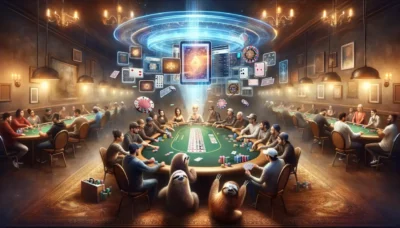By: Charlon Muscat
Poker demands sharp thinking and an understanding of human behavior – a game that has long held a place in the hearts of both amateur and professional players. The global appeal is undeniable, drawing millions into its fold with the promise of challenge and reward. Now that it has extended into online play, poker continued to transform traditional boundaries and access points making it even more accessible than ever. But how do the experiences of playing in a physical setting differ from those faced online? Let’s explore these two distinct environments.
Breaking Down Poker

The traditional poker game has evolved into numerous variants, each with its own set of rules and strategies. Yet, the core objective remains constant: to win the pot, either by holding the best hand at the showdown or by convincing others to fold through tactical betting. Key elements of the game are the following:
- Card distribution: It initiates with the dealer distributing cards to each participant. The exact number depends on the variant, but the goal is to use these cards to form a winning combination.
- Betting phases: During the betting rounds, players assess the strength of their hands and decide whether to bet, raise, call, or fold.
- Hand strength: The hierarchy of hands ranges from the highest (royal flush) to a single high card. The participant with the strongest one, or the last one standing after others fold, wins the pot.
- Strategic play: This can be done through bluffing, which is all about betting strongly on a weak hand to convince others to fold or through reading “tells,” or behavioral signs, of others to gauge the strength of their hands.
Then, if multiple players remain after the final betting round, they reveal their hands. The best hand, according to the game’s rules, wins the entire pot.
In-Person Poker Experience
Face-to-face interactions form the cornerstone of in-person play, enabling for a direct engagement with opponents. The physical act of handling chips and feeling the weight of cards in hand, whether it’s a land-based casino, poker room, or an exclusive club, also adds a tangible element to the game.
Such an environment fosters a unique space to read body language, which, as explained, helps players look for any hint of a bluff or a tell revealing the strength of an opponent’s hand. These interactions and the strategic play create something that could be more challenging to replicate outside the live setting.
Amidst the clinking of chips, the shuffle of decks, and the concentration on players’ faces, the sensory experience creates a backdrop rich with the sounds of conversation and competitive spirit. It undoubtedly contributes to an atmosphere charged with tension and excitement.
Online Poker Experience
The online experience revolutionizes accessibility since it allows us to dive into the game from any location at any time. This convenience extends to various platforms, including mobile apps, $5 minimum deposit casino USA, and dedicated sites that host several tournaments and events, all offering games that range from classic Texas Hold’em to more niche variations like Omaha, the fast-paced action of Seven-Card Stud, and the intriguing complexities of Razz.
Advancements in technology like software tools and Heads Up Displays (HUDs) offer deep insights into one’s own playstyles and those of their opponents which elevates strategic planning to new heights. These transform raw data into actionable intelligence and, therefore, enable players to make more informed decisions while refining their tactics in real-time.
The online world of poker is as inclusive as it is expansive. It opens doors to global competitions, sit-and-go’s, and freerolls, which could be high-stakes tables at renowned online tournaments or casual games designed for newcomers, all to invite people from all corners of the globe to test their mettle against each other.
Online vs. In-Person
Strategies undergo a significant transformation when moving between online and in-person environments, primarily due to the distinct nature of each setting. This divergence manifests in various aspects:
Physical Tells vs. Statistical Analysis
In-person games thrive on the ability to interpret opponents’ physical tells, while online poker, devoid of such visual cues, shifts the focus towards statistical analysis and pattern recognition, with players leveraging software to gain insights into opponents’ behaviors and tendencies.
Adaptation and Learning
Newcomers in live settings often navigate a steep learning curve when it comes to mastering the game’s rules and the art of reading opponents through resources like books, live workshops, and observation. Learning tools for the online space could be instructional videos or interactive software, amongst others.
Social Dynamics
Direct interaction in live poker allows for psychological play beyond the cards, where banter and live tells contribute to the game’s strategic layer. Although online play lacks face-to-face interaction, it compensates with an extensive, accessible community. Forums, chat rooms, and social media platforms connect players globally, facilitate strategy exchanges and foster a sense of belonging among distant peers.
